TOYOTA AYGO X 2022 Owners Manual (in English)
Manufacturer: TOYOTA, Model Year: 2022, Model line: AYGO X, Model: TOYOTA AYGO X 2022Pages: 494, PDF Size: 92.53 MB
Page 101 of 494
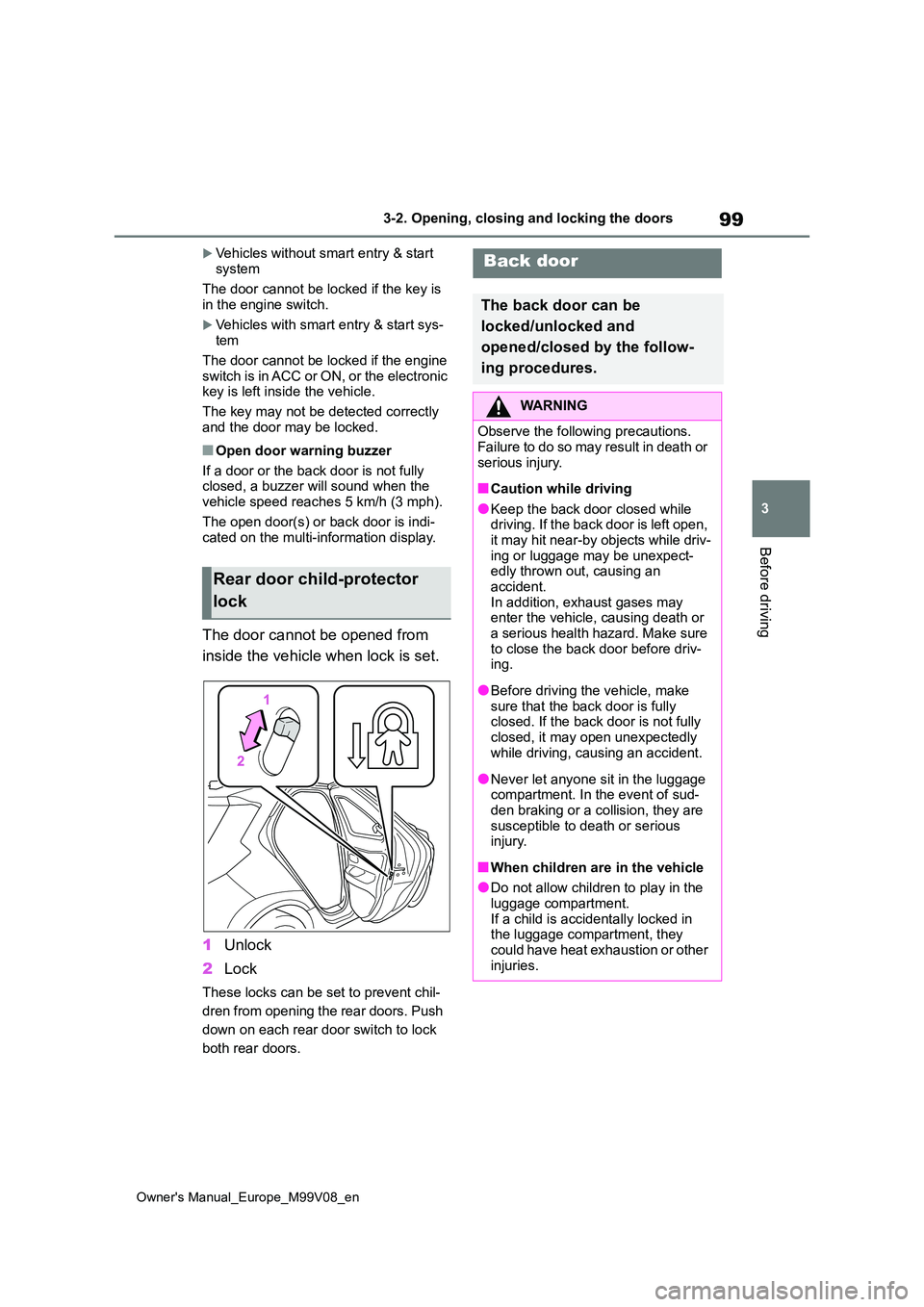
99
3
Owner's Manual_Europe_M99V08_en
3-2. Opening, closing and locking the doors
Before driving
Vehicles without smart entry & start
system
The door cannot be locked if the key is in the engine switch.
Vehicles with smart entry & start sys-tem
The door cannot be locked if the engine
switch is in ACC or ON, or the electronic key is left inside the vehicle.
The key may not be detected correctly
and the door may be locked.
■Open door warning buzzer
If a door or the back door is not fully closed, a buzzer will sound when the
vehicle speed reaches 5 km/h (3 mph).
The open door(s) or back door is indi- cated on the multi-information display.
The door cannot be opened from
inside the vehicle when lock is set.
1 Unlock
2 Lock
These locks can be set to prevent chil-
dren from opening the rear doors. Push
down on each rear door switch to lock
both rear doors.
Rear door child-protector
lock
Back door
The back door can be
locked/unlocked and
opened/closed by the follow-
ing procedures.
WARNING
Observe the following precautions. Failure to do so may result in death or
serious injury.
■Caution while driving
●Keep the back door closed while driving. If the back door is left open, it may hit near-by objects while driv-
ing or luggage may be unexpect- edly thrown out, causing an accident.
In addition, exhaust gases may enter the vehicle, causing death or a serious health hazard. Make sure
to close the back door before driv- ing.
●Before driving the vehicle, make sure that the back door is fully closed. If the back door is not fully
closed, it may open unexpectedly while driving, causing an accident.
●Never let anyone sit in the luggage compartment. In the event of sud-den braking or a collision, they are
susceptible to death or serious injury.
■When children are in the vehicle
●Do not allow children to play in the luggage compartment.
If a child is accidentally locked in the luggage compartment, they could have heat exhaustion or other
injuries.
Page 102 of 494
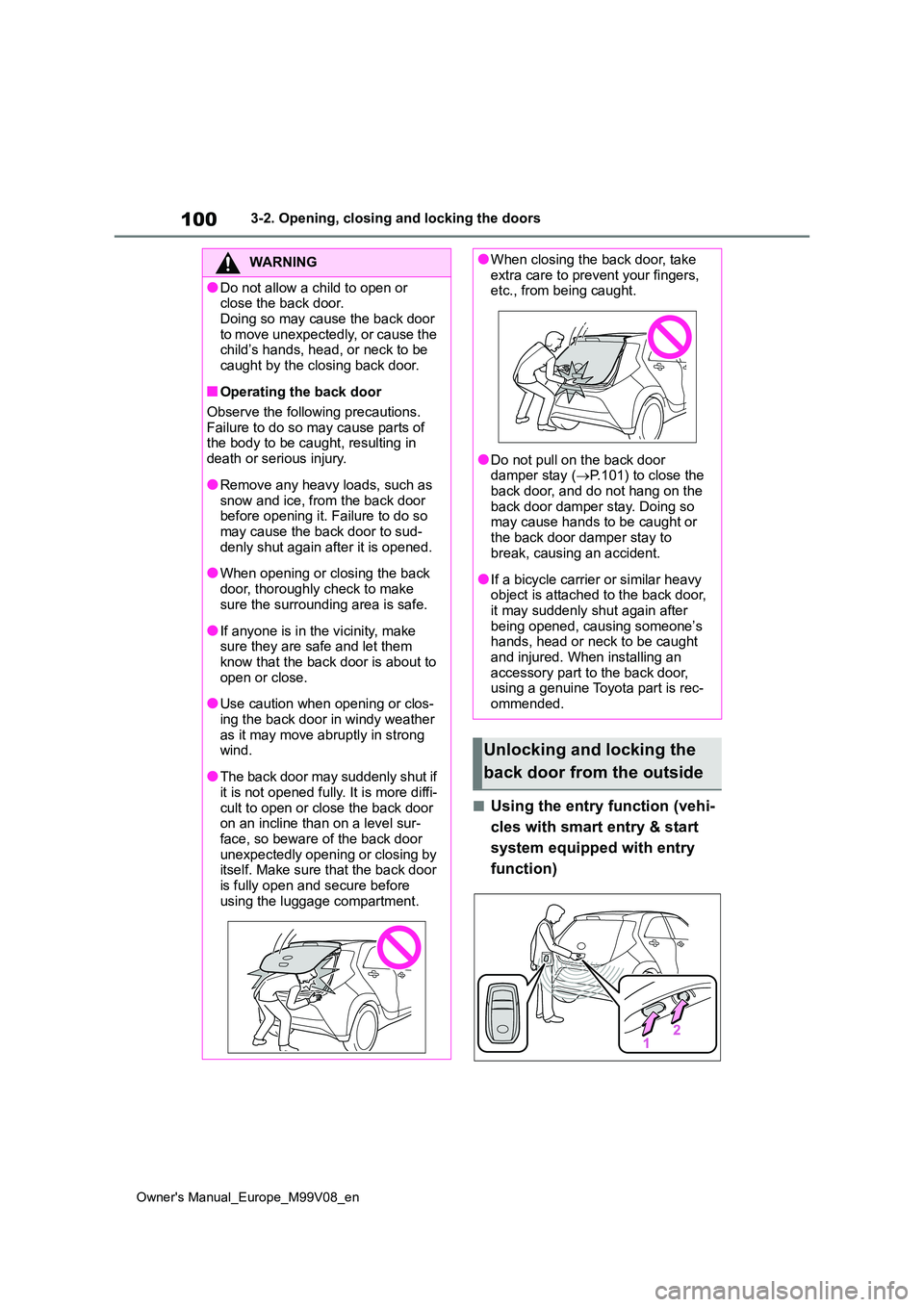
100
Owner's Manual_Europe_M99V08_en
3-2. Opening, closing and locking the doors
■Using the entry function (vehi-
cles with smart entry & start
system equipped with entry
function)
WARNING
●Do not allow a child to open or close the back door.
Doing so may cause the back door to move unexpectedly, or cause the child’s hands, head, or neck to be
caught by the closing back door.
■Operating the back door
Observe the following precautions. Failure to do so may cause parts of the body to be caught, resulting in
death or serious injury.
●Remove any heavy loads, such as
snow and ice, from the back door before opening it. Failure to do so may cause the back door to sud-
denly shut again after it is opened.
●When opening or closing the back
door, thoroughly check to make sure the surrounding area is safe.
●If anyone is in the vicinity, make sure they are safe and let them know that the back door is about to
open or close.
●Use caution when opening or clos-
ing the back door in windy weather as it may move abruptly in strong wind.
●The back door may suddenly shut if it is not opened fully. It is more diffi-
cult to open or close the back door on an incline than on a level sur-face, so beware of the back door
unexpectedly opening or closing by itself. Make sure that the back door is fully open and secure before
using the luggage compartment.
●When closing the back door, take extra care to prevent your fingers, etc., from being caught.
●Do not pull on the back door damper stay ( P.101) to close the
back door, and do not hang on the back door damper stay. Doing so may cause hands to be caught or
the back door damper stay to break, causing an accident.
●If a bicycle carrier or similar heavy object is attached to the back door, it may suddenly shut again after
being opened, causing someone’s hands, head or neck to be caught and injured. When installing an
accessory part to the back door, using a genuine Toyota part is rec-ommended.
Unlocking and locking the
back door from the outside
Page 103 of 494
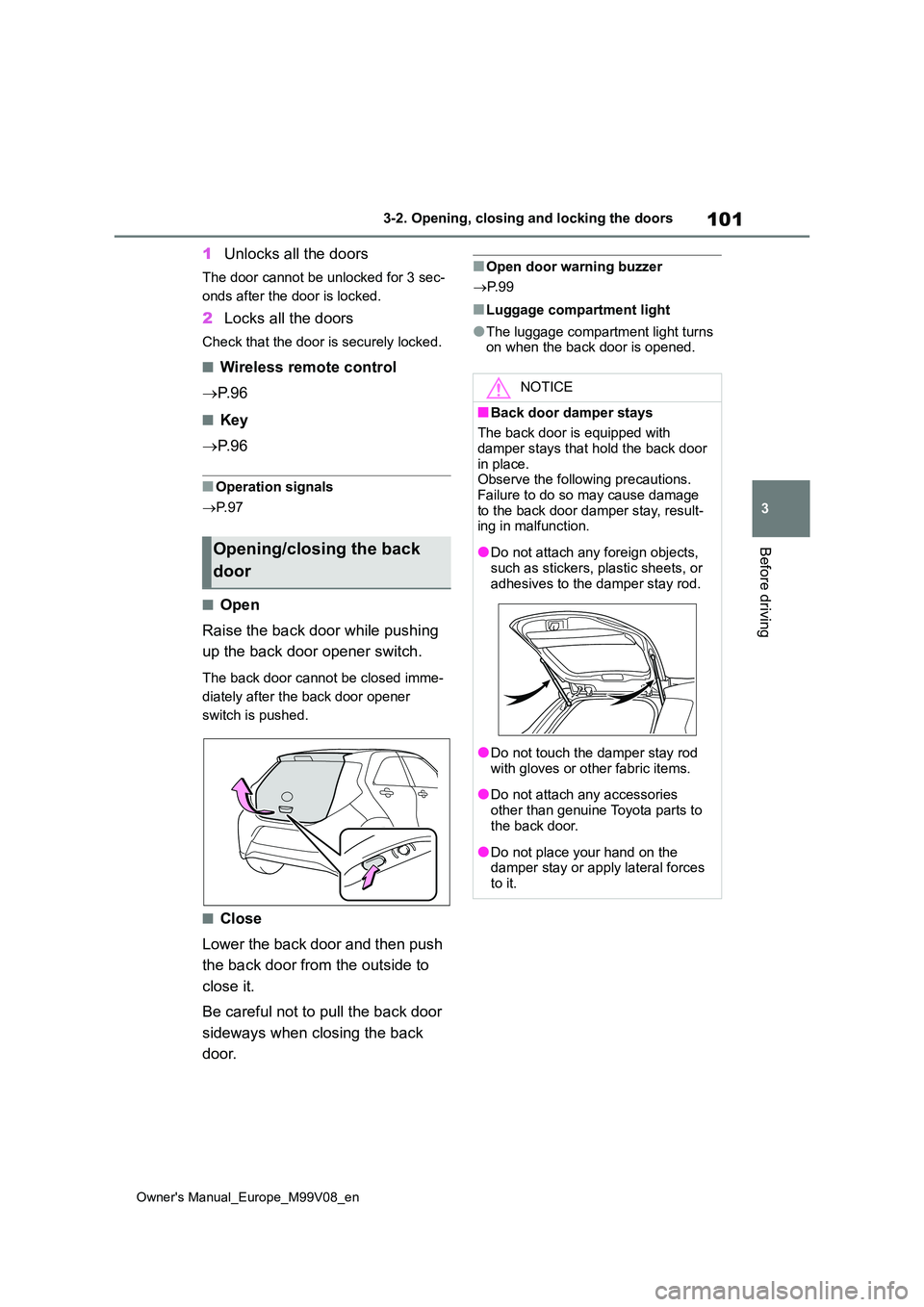
101
3
Owner's Manual_Europe_M99V08_en
3-2. Opening, closing and locking the doors
Before driving
1Unlocks all the doors
The door cannot be unlocked for 3 sec-
onds after the door is locked.
2 Locks all the doors
Check that the door is securely locked.
■Wireless remote control
P. 9 6
■Key
P. 9 6
■Operation signals
P. 9 7
■Open
Raise the back door while pushing
up the back door opener switch.
The back door cannot be closed imme-
diately after the back door opener
switch is pushed.
■Close
Lower the back door and then push
the back door from the outside to
close it.
Be careful not to pull the back door
sideways when closing the back
door.
■Open door warning buzzer
P. 9 9
■Luggage compartment light
●The luggage compartment light turns on when the back door is opened.
Opening/closing the back
door
NOTICE
■Back door damper stays
The back door is equipped with
damper stays that hold the back door in place.Observe the following precautions.
Failure to do so may cause damage to the back door damper stay, result-ing in malfunction.
●Do not attach any foreign objects, such as stickers, plastic sheets, or
adhesives to the damper stay rod.
●Do not touch the damper stay rod
with gloves or other fabric items.
●Do not attach any accessories
other than genuine Toyota parts to the back door.
●Do not place your hand on the damper stay or apply lateral forces to it.
Page 104 of 494
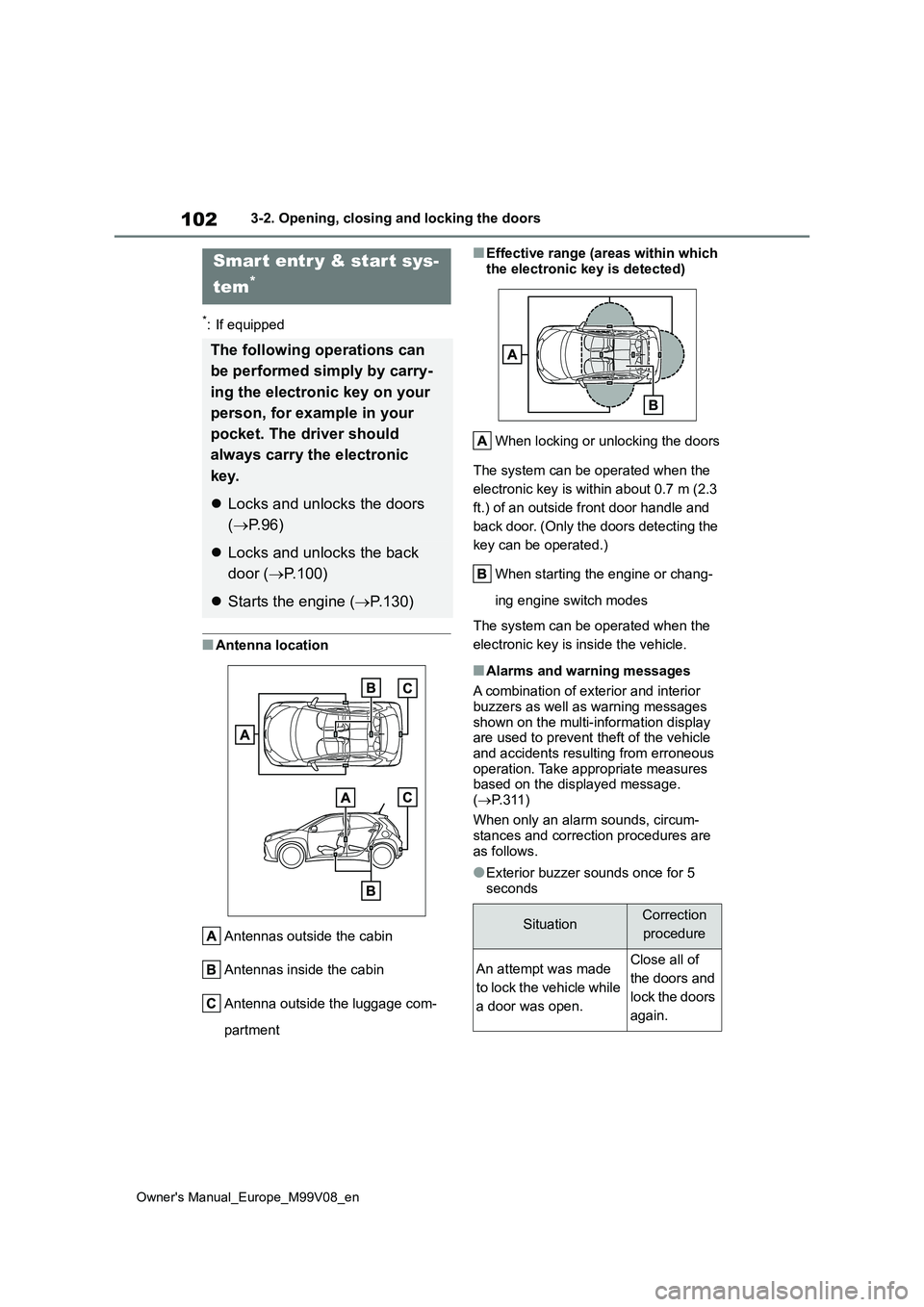
102
Owner's Manual_Europe_M99V08_en
3-2. Opening, closing and locking the doors
*: If equipped
■Antenna location
Antennas outside the cabin
Antennas inside the cabin
Antenna outside the luggage com-
partment
■Effective range (areas within which
the electronic key is detected)
When locking or unlocking the doors
The system can be operated when the
electronic key is within about 0.7 m (2.3
ft.) of an outside front door handle and
back door. (Only the doors detecting the
key can be operated.)
When starting the engine or chang-
ing engine switch modes
The system can be operated when the
electronic key is inside the vehicle.
■Alarms and warning messages
A combination of exterior and interior
buzzers as well as warning messages shown on the multi-information display are used to prevent theft of the vehicle
and accidents resulting from erroneous operation. Take appropriate measures based on the displayed message.
( P. 3 1 1 )
When only an alarm sounds, circum-
stances and correction procedures are as follows.
●Exterior buzzer sounds once for 5 seconds
Smart entr y & start sys-
tem*
The following operations can
be performed simply by carry-
ing the electronic key on your
person, for example in your
pocket. The driver should
always carry the electronic
key.
Locks and unlocks the doors
( P. 9 6 )
Locks and unlocks the back
door ( P.100)
Starts the engine (P.130)
SituationCorrection
procedure
An attempt was made
to lock the vehicle while
a door was open.
Close all of
the doors and
lock the doors
again.
Page 105 of 494
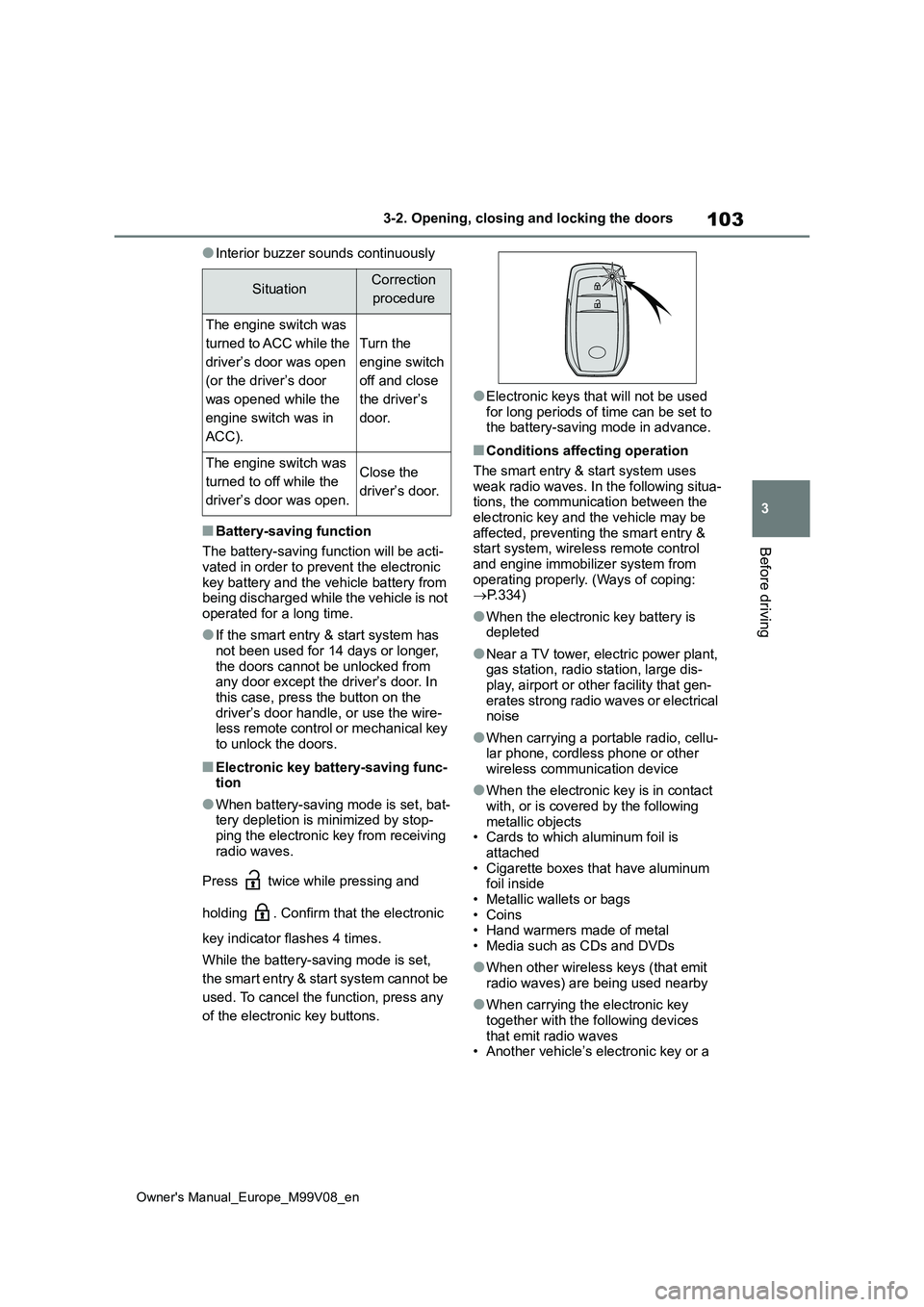
103
3
Owner's Manual_Europe_M99V08_en
3-2. Opening, closing and locking the doors
Before driving
●Interior buzzer sounds continuously
■Battery-saving function
The battery-saving function will be acti-
vated in order to prevent the electronic key battery and the vehicle battery from being discharged while the vehicle is not
operated for a long time.
●If the smart entry & start system has
not been used for 14 days or longer, the doors cannot be unlocked from any door except the driver’s door. In
this case, press the button on the driver’s door handle, or use the wire-less remote control or mechanical key
to unlock the doors.
■Electronic key battery-saving func- tion
●When battery-saving mode is set, bat-tery depletion is minimized by stop-ping the electronic key from receiving
radio waves.
Press twice while pressing and
holding . Confirm that the electronic
key indicator flashes 4 times.
While the battery-saving mode is set,
the smart entry & start system cannot be
used. To cancel the function, press any
of the electronic key buttons.
●Electronic keys that will not be used
for long periods of time can be set to the battery-saving mode in advance.
■Conditions affecting operation
The smart entry & start system uses
weak radio waves. In the following situa- tions, the communication between the electronic key and the vehicle may be
affected, preventing the smart entry & start system, wireless remote control and engine immobilizer system from
operating properly. (Ways of coping: P.334)
●When the electronic key battery is depleted
●Near a TV tower, electric power plant, gas station, radio station, large dis-play, airport or other facility that gen-
erates strong radio waves or electrical noise
●When carrying a portable radio, cellu-lar phone, cordless phone or other wireless communication device
●When the electronic key is in contact with, or is covered by the following
metallic objects • Cards to which aluminum foil is attached
• Cigarette boxes that have aluminum foil inside• Metallic wallets or bags
•Coins • Hand warmers made of metal• Media such as CDs and DVDs
●When other wireless keys (that emit radio waves) are being used nearby
●When carrying the electronic key together with the following devices
that emit radio waves • Another vehicle’s electronic key or a
SituationCorrection
procedure
The engine switch was
turned to ACC while the
driver’s door was open
(or the driver’s door
was opened while the
engine switch was in
ACC).
Turn the
engine switch
off and close
the driver’s
door.
The engine switch was
turned to off while the
driver’s door was open.
Close the
driver’s door.
Page 106 of 494
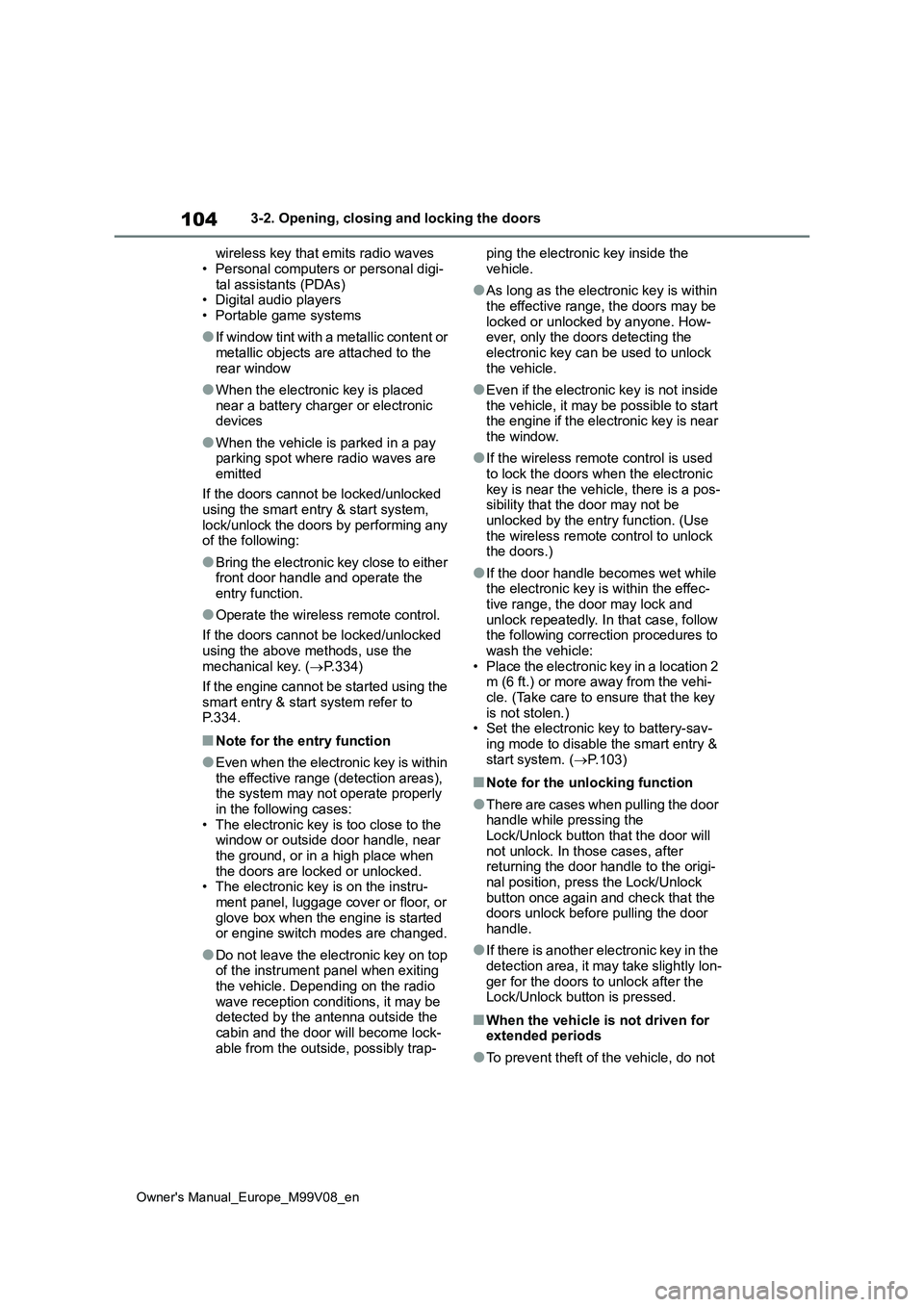
104
Owner's Manual_Europe_M99V08_en
3-2. Opening, closing and locking the doors
wireless key that emits radio waves
• Personal computers or personal digi- tal assistants (PDAs)• Digital audio players
• Portable game systems
●If window tint with a metallic content or
metallic objects are attached to the rear window
●When the electronic key is placed near a battery charger or electronic devices
●When the vehicle is parked in a pay parking spot where radio waves are
emitted
If the doors cannot be locked/unlocked using the smart entry & start system,
lock/unlock the doors by performing any of the following:
●Bring the electronic key close to either front door handle and operate the entry function.
●Operate the wireless remote control.
If the doors cannot be locked/unlocked
using the above methods, use the mechanical key. ( P.334)
If the engine cannot be started using the
smart entry & start system refer to P.334.
■Note for the entry function
●Even when the electronic key is within the effective range (detection areas), the system may not operate properly
in the following cases: • The electronic key is too close to the window or outside door handle, near
the ground, or in a high place when the doors are locked or unlocked.• The electronic key is on the instru-
ment panel, luggage cover or floor, or glove box when the engine is started or engine switch modes are changed.
●Do not leave the electronic key on top of the instrument panel when exiting
the vehicle. Depending on the radio wave reception conditions, it may be detected by the antenna outside the
cabin and the door will become lock- able from the outside, possibly trap-
ping the electronic key inside the
vehicle.
●As long as the electronic key is within
the effective range, the doors may be locked or unlocked by anyone. How-ever, only the doors detecting the
electronic key can be used to unlock the vehicle.
●Even if the electronic key is not inside the vehicle, it may be possible to start the engine if the electronic key is near
the window.
●If the wireless remote control is used
to lock the doors when the electronic key is near the vehicle, there is a pos-sibility that the door may not be
unlocked by the entry function. (Use the wireless remote control to unlock the doors.)
●If the door handle becomes wet while the electronic key is within the effec-
tive range, the door may lock and unlock repeatedly. In that case, follow the following correction procedures to
wash the vehicle: • Place the electronic key in a location 2 m (6 ft.) or more away from the vehi-
cle. (Take care to ensure that the key is not stolen.)• Set the electronic key to battery-sav-
ing mode to disable the smart entry & start system. ( P.103)
■Note for the unlocking function
●There are cases when pulling the door handle while pressing the Lock/Unlock button that the door will
not unlock. In those cases, after returning the door handle to the origi-nal position, press the Lock/Unlock
button once again and check that the doors unlock before pulling the door handle.
●If there is another electronic key in the detection area, it may take slightly lon-
ger for the doors to unlock after the Lock/Unlock button is pressed.
■When the vehicle is not driven for extended periods
●To prevent theft of the vehicle, do not
Page 107 of 494
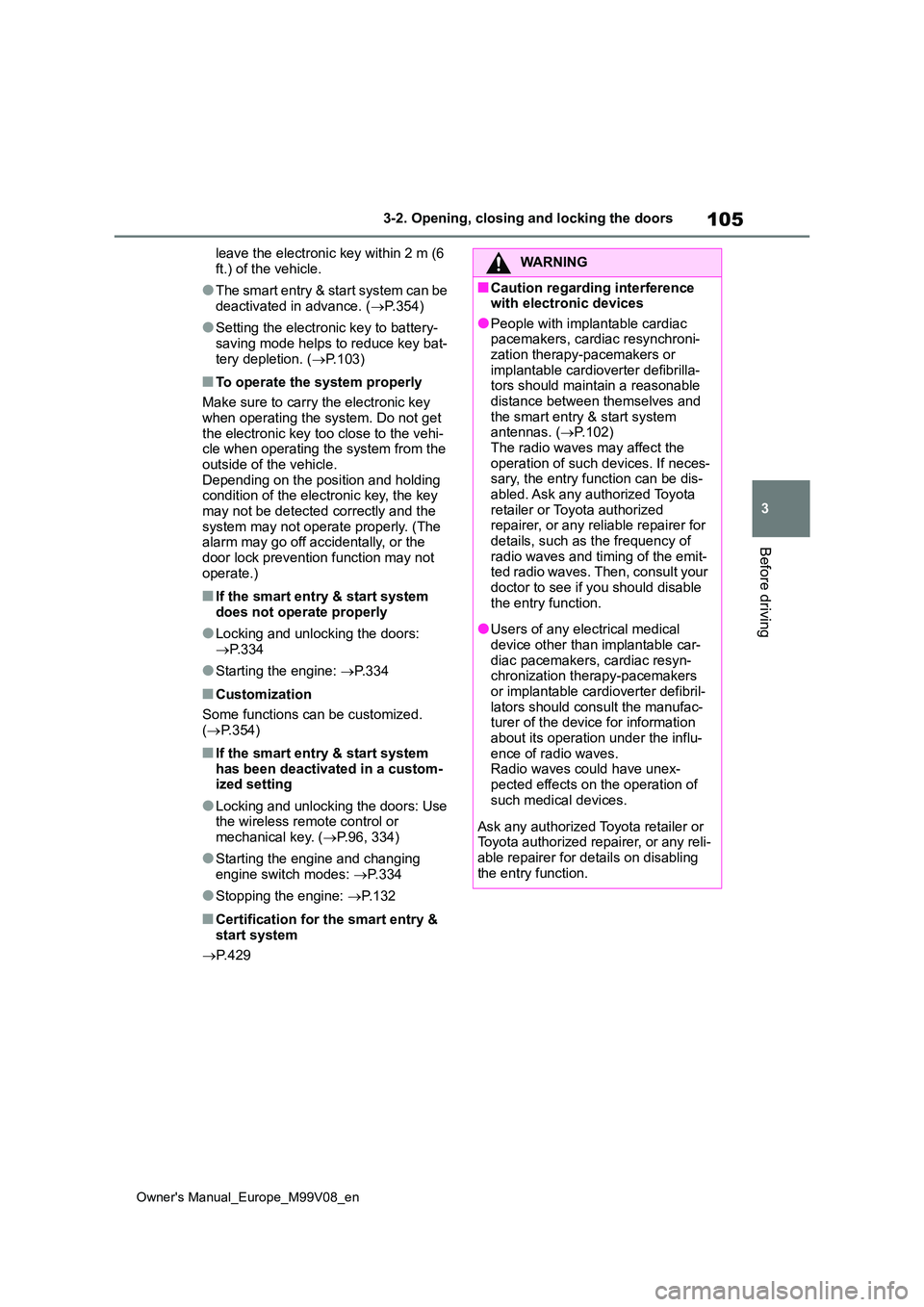
105
3
Owner's Manual_Europe_M99V08_en
3-2. Opening, closing and locking the doors
Before driving
leave the electronic key within 2 m (6
ft.) of the vehicle.
●The smart entry & start system can be
deactivated in advance. ( P.354)
●Setting the electronic key to battery-
saving mode helps to reduce key bat- tery depletion. ( P.103)
■To operate the system properly
Make sure to carry the electronic key
when operating the system. Do not get the electronic key too close to the vehi-cle when operating the system from the
outside of the vehicle. Depending on the position and holding condition of the electronic key, the key
may not be detected correctly and the system may not operate properly. (The alarm may go off accidentally, or the
door lock prevention function may not operate.)
■If the smart entry & start system does not operate properly
●Locking and unlocking the doors: P. 3 3 4
●Starting the engine: P.334
■Customization
Some functions can be customized.
( P.354)
■If the smart entry & start system has been deactivated in a custom-ized setting
●Locking and unlocking the doors: Use the wireless remote control or
mechanical key. ( P.96, 334)
●Starting the engine and changing
engine switch modes: P. 3 3 4
●Stopping the engine: P. 1 3 2
■Certification for the smart entry &
start system
P. 4 2 9
WARNING
■Caution regarding interference with electronic devices
●People with implantable cardiac pacemakers, cardiac resynchroni-zation therapy-pacemakers or
implantable cardioverter defibrilla- tors should maintain a reasonable distance between themselves and
the smart entry & start system antennas. ( P.102) The radio waves may affect the
operation of such devices. If neces- sary, the entry function can be dis-abled. Ask any authorized Toyota
retailer or Toyota authorized repairer, or any reliable repairer for details, such as the frequency of
radio waves and timing of the emit- ted radio waves. Then, consult your doctor to see if you should disable
the entry function.
●Users of any electrical medical
device other than implantable car- diac pacemakers, cardiac resyn-chronization therapy-pacemakers
or implantable cardioverter defibril- lators should consult the manufac-turer of the device for information
about its operation under the influ- ence of radio waves.Radio waves could have unex-
pected effects on the operation of such medical devices.
Ask any authorized Toyota retailer or Toyota authorized repairer, or any reli-able repairer for details on disabling
the entry function.
Page 108 of 494
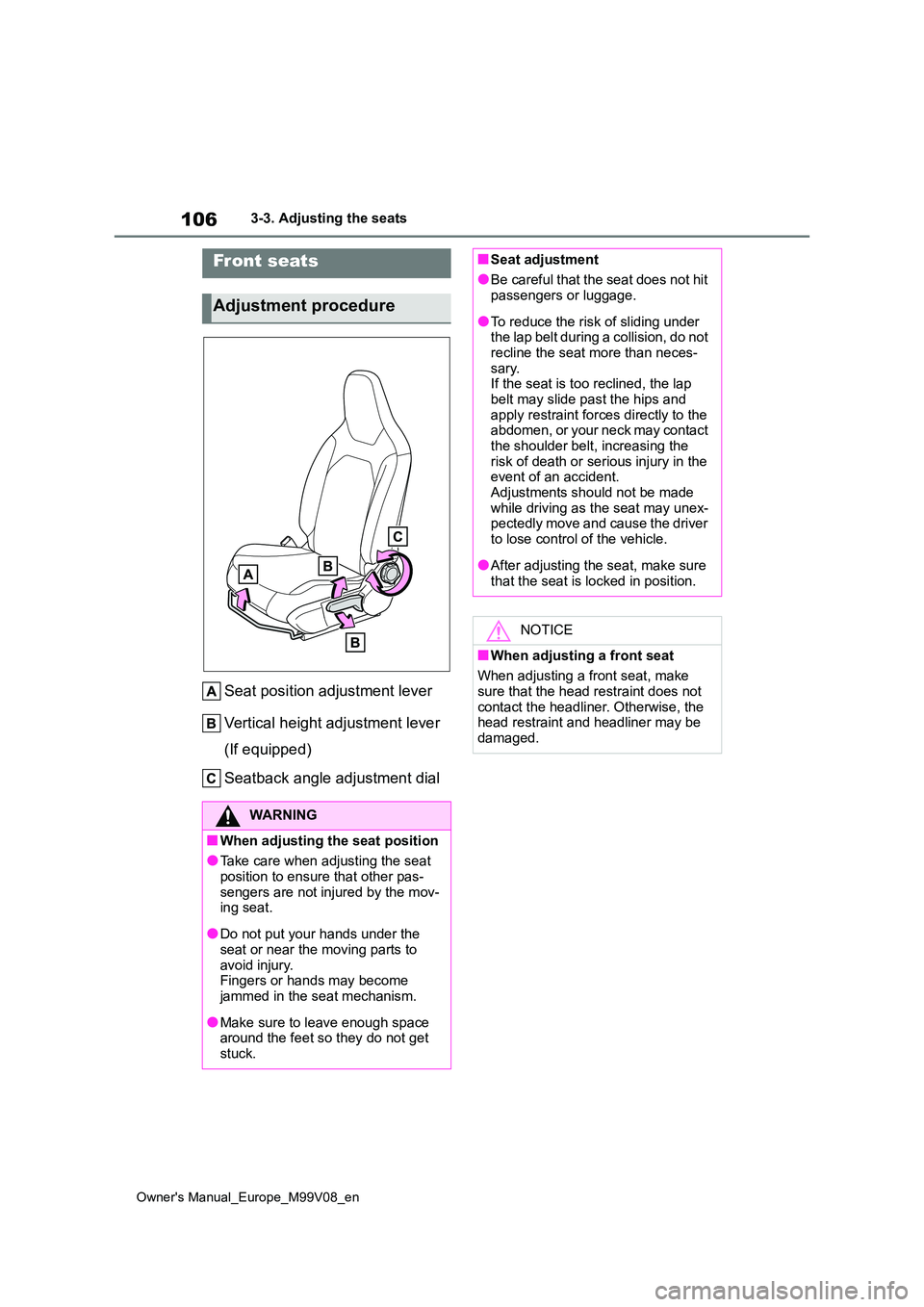
106
Owner's Manual_Europe_M99V08_en
3-3. Adjusting the seats
3-3.Adjusting the sea ts
Seat position adjustment lever
Vertical height adjustment lever
(If equipped)
Seatback angle adjustment dial
Front seats
Adjustment procedure
WARNING
■When adjusting the seat position
●Take care when adjusting the seat
position to ensure that other pas- sengers are not injured by the mov-ing seat.
●Do not put your hands under the seat or near the moving parts to
avoid injury. Fingers or hands may become jammed in the seat mechanism.
●Make sure to leave enough space around the feet so they do not get
stuck.
■Seat adjustment
●Be careful that the seat does not hit passengers or luggage.
●To reduce the risk of sliding under the lap belt during a collision, do not
recline the seat more than neces- sary.If the seat is too reclined, the lap
belt may slide past the hips and apply restraint forces directly to the abdomen, or your neck may contact
the shoulder belt, increasing the risk of death or serious injury in the event of an accident.
Adjustments should not be made while driving as the seat may unex-pectedly move and cause the driver
to lose control of the vehicle.
●After adjusting the seat, make sure
that the seat is locked in position.
NOTICE
■When adjusting a front seat
When adjusting a front seat, make
sure that the head restraint does not contact the headliner. Otherwise, the head restraint and headliner may be
damaged.
Page 109 of 494
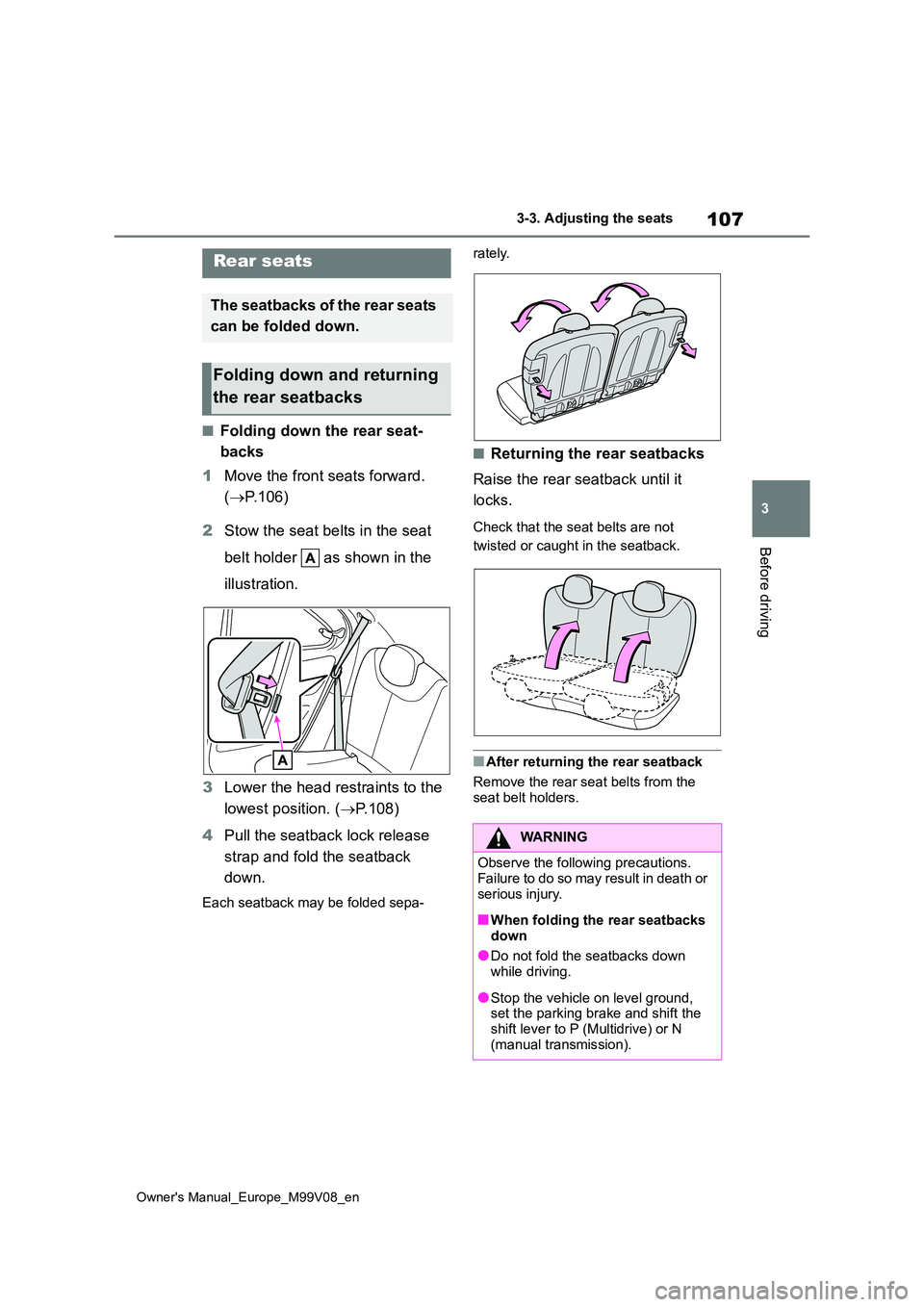
107
3
Owner's Manual_Europe_M99V08_en
3-3. Adjusting the seats
Before driving
■Folding down the rear seat-
backs
1 Move the front seats forward.
( P.106)
2 Stow the seat belts in the seat
belt holder as shown in the
illustration.
3 Lower the head restraints to the
lowest position. ( P.108)
4 Pull the seatback lock release
strap and fold the seatback
down.
Each seatback may be folded sepa-
rately.
■Returning the rear seatbacks
Raise the rear seatback until it
locks.
Check that the seat belts are not
twisted or caught in the seatback.
■After returning the rear seatback
Remove the rear seat belts from the
seat belt holders.
Rear seats
The seatbacks of the rear seats
can be folded down.
Folding down and returning
the rear seatbacks
WARNING
Observe the following precautions. Failure to do so may result in death or
serious injury.
■When folding the rear seatbacks
down
●Do not fold the seatbacks down while driving.
●Stop the vehicle on level ground, set the parking brake and shift the
shift lever to P (Multidrive) or N (manual transmission).
Page 110 of 494
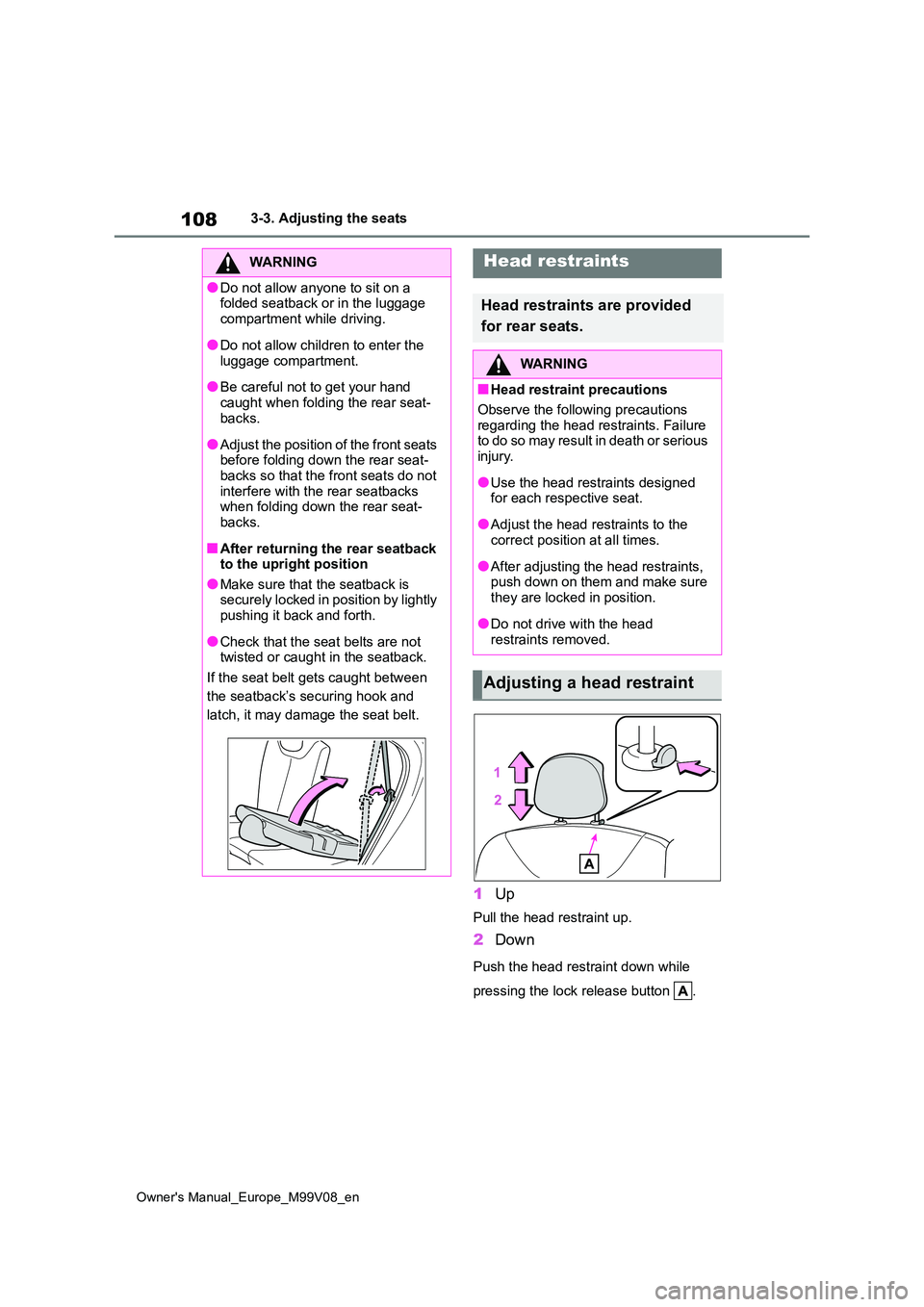
108
Owner's Manual_Europe_M99V08_en
3-3. Adjusting the seats
1Up
Pull the head restraint up.
2Down
Push the head restraint down while
pressing the lock release button .
WARNING
●Do not allow anyone to sit on a folded seatback or in the luggage
compartment while driving.
●Do not allow children to enter the
luggage compartment.
●Be careful not to get your hand
caught when folding the rear seat- backs.
●Adjust the position of the front seats before folding down the rear seat-backs so that the front seats do not
interfere with the rear seatbacks when folding down the rear seat-backs.
■After returning the rear seatback to the upright position
●Make sure that the seatback is securely locked in position by lightly pushing it back and forth.
●Check that the seat belts are not twisted or caught in the seatback.
If the seat belt gets caught between
the seatback’s securing hook and
latch, it may damage the seat belt.
Head restraints
Head restraints are provided
for rear seats.
WARNING
■Head restraint precautions
Observe the following precautions
regarding the head restraints. Failure to do so may result in death or serious injury.
●Use the head restraints designed for each respective seat.
●Adjust the head restraints to the correct position at all times.
●After adjusting the head restraints, push down on them and make sure
they are locked in position.
●Do not drive with the head
restraints removed.
Adjusting a head restraint